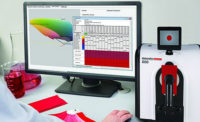Color and appearance are two of the most essential attributes of a final product. If the color doesn’t look right or assembled parts don’t match, consumers won’t buy. As brands and their suppliers adopt digital workflows to help accelerate product ideation and reduce waste, companies need to go beyond color and digitize both color and appearance characteristics.
For many companies, digital color means incorporating digital color standards based on the underlying spectral data measured by a spectrophotometer. The digital standard is shared across the supply chain to ensure accurate color in all stages, from design through pre-production, production, and quality control. The spectral data is used in formulation software and quality control tools, helping companies match and quickly produce accurate color. But is spectral data enough for today’s new digital workflows, especially for virtual prototyping?
Digitization Beyond Spectral Data
If you only digitize color using spectral data, you are missing valuable data required for the digital design and visualization workflow. While spectral data can be used, it lacks the integration of real-world materials. This means you cannot create a realistic digital material twin and visualize how a color will look on a material for virtual prototyping or quality control.
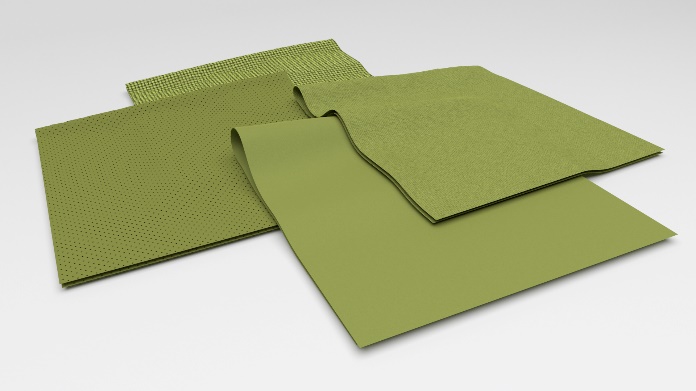
Digital rending of different materials all in Pantone Turtle Green.
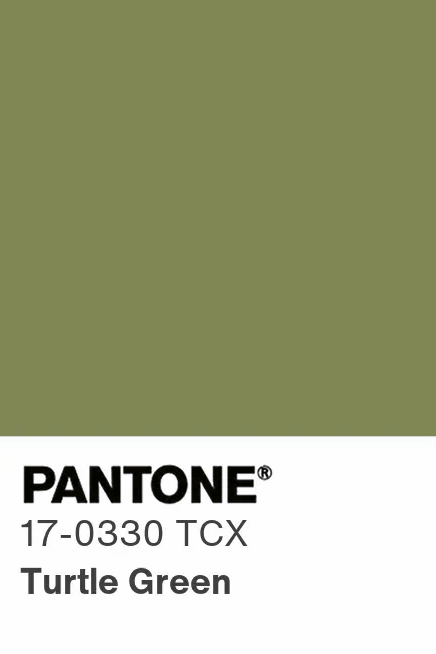
Pantone 17-0330 TCX – Turtle Green
Consider the following: A brand designer selects Turtle Green, Pantone 17-0330 TCX, for an upcoming collection. The color will be used across meshes, velvets, satins, and leathers. Although each of these materials are the same color, the final appearance will differ based on the texture, weave, and shine.
When viewing physical samples, our brain and eyes have learned how to perceive differences in materials by comparing them in multiple dimensions. We can move items around to understand how light interacts, giving us a perception of color variation due to texture, gloss, etc. However, in a digital workflow, the appearance characteristics dictate how color is rendered on a material or object. This means our 3-dimensional view of color – light, chroma, and hue – must expand to include appearance characteristics such as gloss, texture, translucency, opacity, etc. to mimic human perception digitally.
Depending on the complexity of the material, digital color workflows now require 6, 7, or even 8 dimensions. As more companies move toward an end-to-end digital design and production process, digital material color and appearance standards must include data that characterizes:
- Diffuse Color: Albedo or body color
- Normal: Material texture
- Specular Color: Color and value of the specular highlight
- Roughness: Material gloss
- Height information: Height topology
- Fresnel: Refraction index for sheen
- Transparency: Material Opacity
- Volumetric: Translucency and sub-surface scattering
- Effect paints: Color flop and flake appearance
- Orange Peel: Clear coat surface texture
- Colored / Tinted Clear Coat: Clear coat color
By digitizing these additional dimensions, brands and suppliers can create digital material twins for paints, plastics, textiles, leathers, and metals. Automotive, consumer electronics, durable goods, apparel, soft goods, and more can use the digital material twin in 3D designs, virtual prototypes and more.
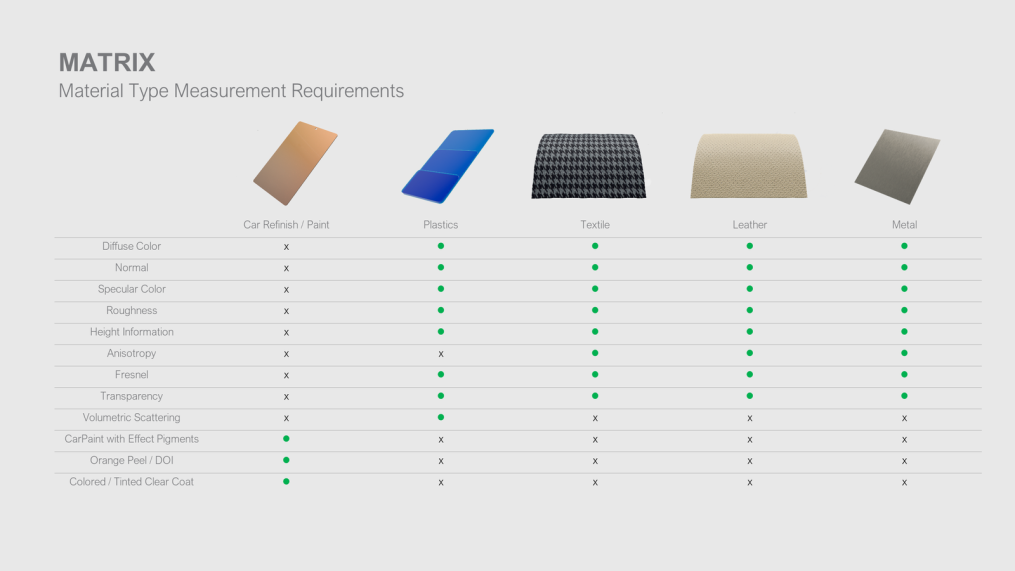
Color and Appearance Measurement requirements by material
Characterizing Appearance
It is now easier than ever and cost effective to characterize appearance and create digital material twins using existing and new spectrophotometers with appearance / visualization software.
This is possible because of the appearance exchange format (AxF). Similar to the color exchange format (CxF), an ISO standard for the sharing spectral data, AxF is the first file format that provides a standard way to store and share all relevant appearance data – color, texture, gloss, refraction, translucency, special effects (sparkles) and reflection properties. AxF files are editable, portable, and can be used with various CAD, PLM, and 3D rendering solutions.
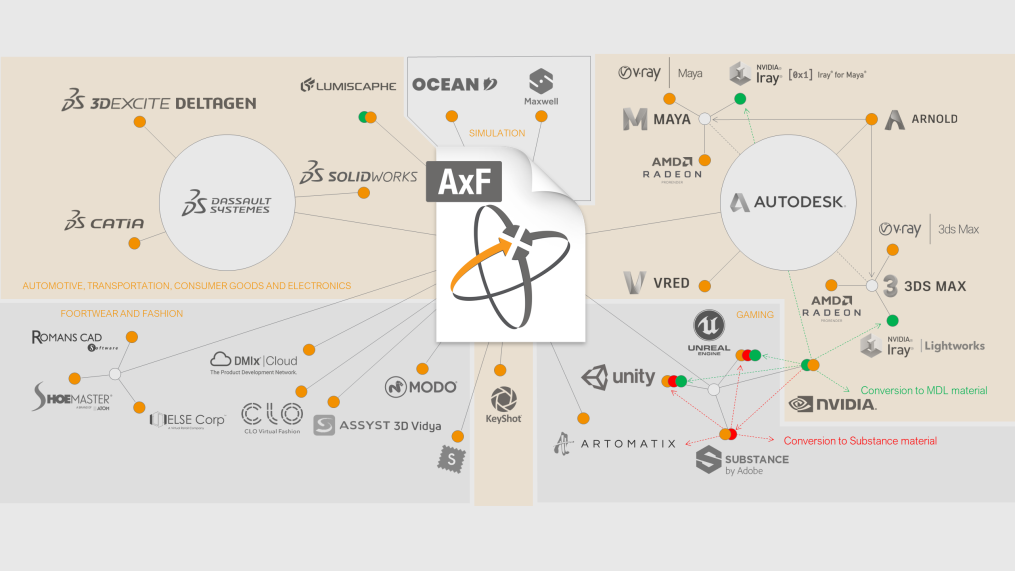
Applications with AxF Support
Using a desktop appearance application, users can import spectral samples to store, manage, view, edit, and render as virtual materials. For example, it is now possible to digitally exchange virtual samples into an Appearance Exchange File (AxF) and allow companies to attach valuable metadata and quality information to the file. This simplifies the management of a large volume of complex color and appearance data and makes it shareable across the design to production value chain for use in 3D rendering software and PLM Systems.
Some desktop applications can connect with spectrophotometers so brands and suppliers can capture and import spectral and appearance data directly into the application for a streamlined workflow. Sphere, multi-angle and imaging spectrophotometers each measure different aspects of appearance, and companies can select the most appropriate device for their application needs.
For example, a desktop application can connect to a multi-angle spectrophotometer and measure and virtualize complex materials that include color, effect finishes, and surface structure such as flake texture and color flop. Sphere spectrophotometers can capture the transmission of color on translucent materials and the reflection of color on opaque materials, both common use cases for plastics. For multi-spectral texture samples, a noncontact imaging spectrophotometer can capture the texture of leather, laminate, and textile samples.
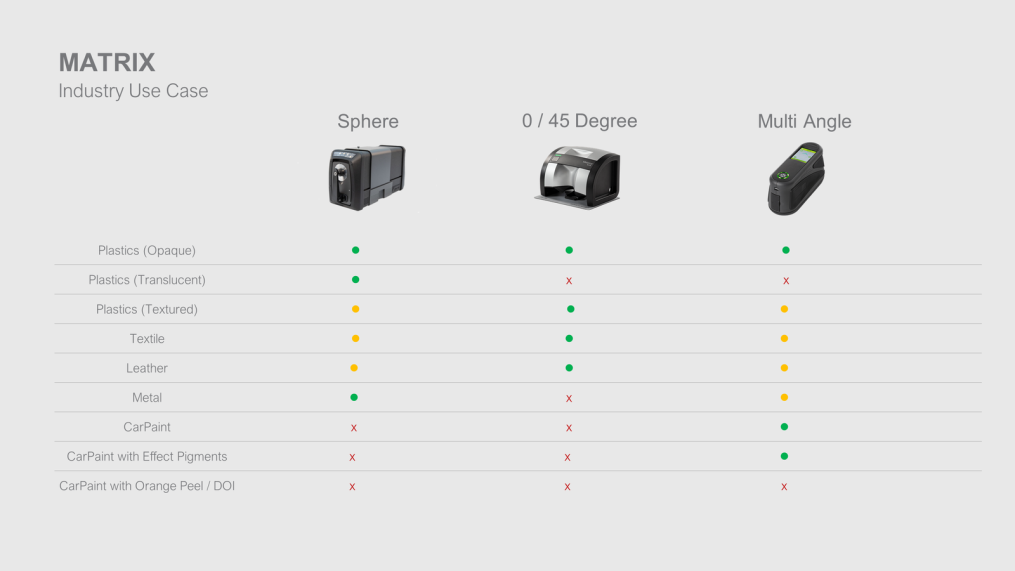
Color and Appearance measurement capabilities by materials and type of spectrophotometer
Virtual Material Model Representations
When evaluating which appearance visualization software and type of spectrophotometer is best for your digital workflow, it is important to understand the material model representation used in AxF. Do your current spectrophotometers already capture elements of appearance data? Can your appearance software convert it into AxF files?
The bidirectional reflectance distribution function (BRDF) material model is the simplest material class supported by the AxF format. BRDF is a 4-dimensional mathematical function that defines how light is reflected at an opaque surface with a uniform appearance. In computer graphics, BRDFs are described by parametric models because they require only a few parameters. (see image 6)
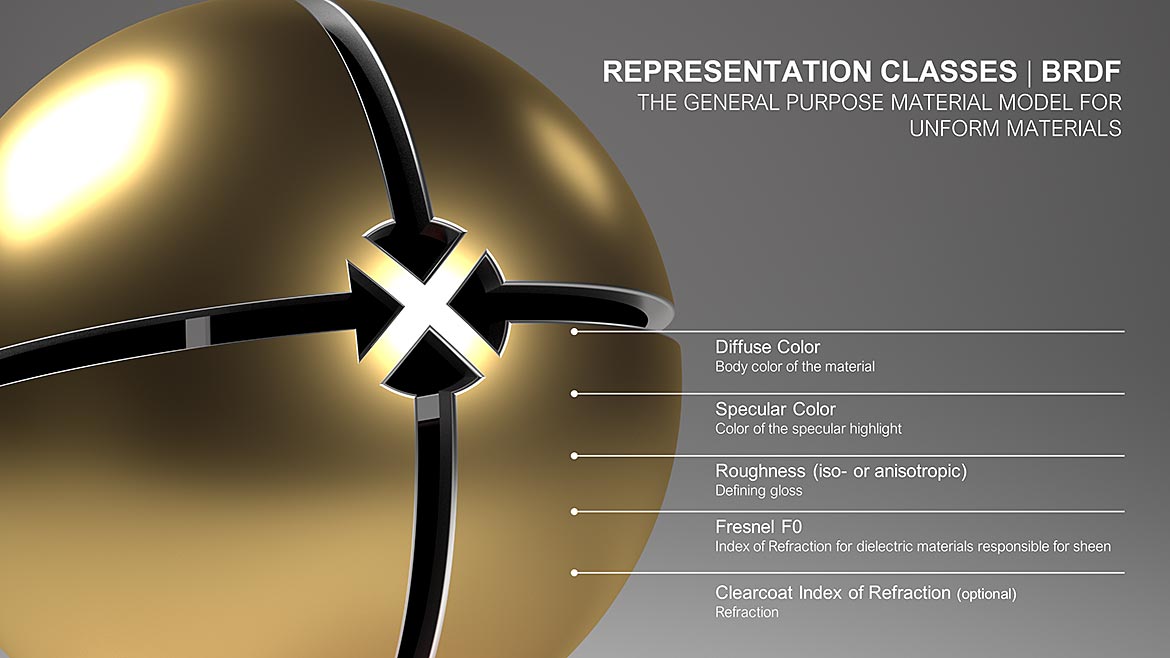
Appearance representation class BRDF.
If a material shows a spatially varying appearance and extended BRDF, a spatially varying bidirectional reflectance distribution function (SVBRDF) must be applied. The SVBRDF model is a 6-dimensional mathematical function. It is like a bitmap graphic, except every pixel represents a full BRDF not just color. SVBRDF models are typically stored in a stack of image files called parameter or texture maps. The most common components of SVBRDF are diffuse color, specular color, roughness, and normal map. SVBRDF maps can also support anisotropic behavior (properties that differ according to the direction of measurement) and height maps, which show a change in geometry of the material. A clearcoat parameter in SVBRDF is used to describe a glossy clearcoat layer on top of a base material.
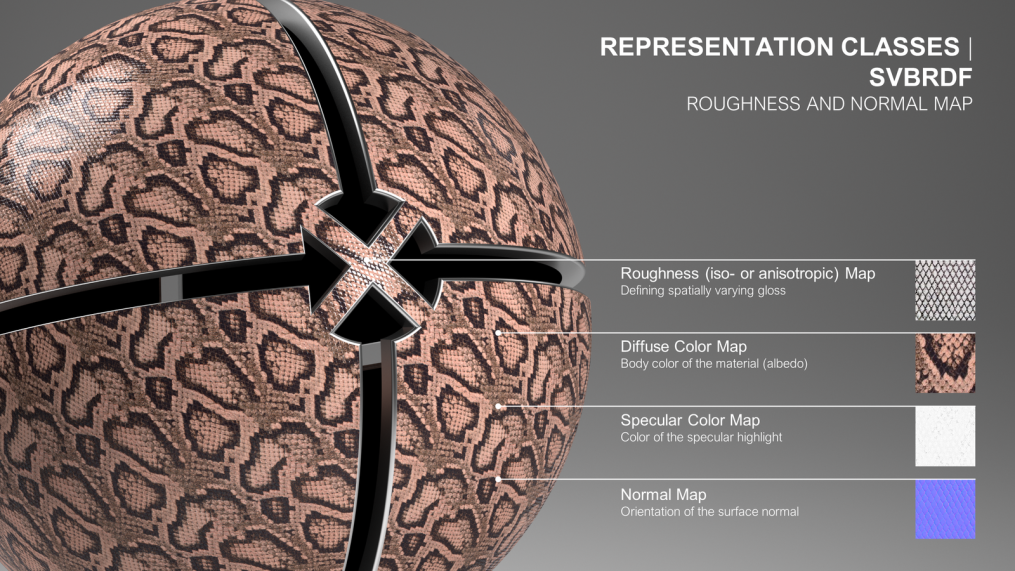
Appearance representation class SVBRDF for roughness and normal map
For paint and coatings, AxF includes a third material model called CPA. This model characterizes three main parameters: flake textures, color table, and brightness. This model is used for special effect paints for automotive and other durable goods.
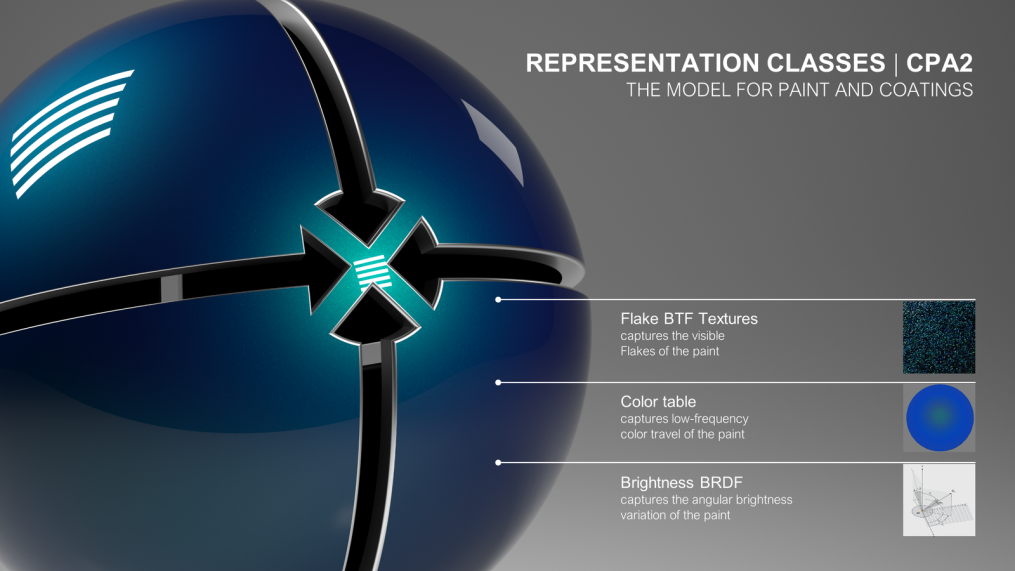
Appearance representation class for paint and coatings
The Future: Virtual Material Sample for Quality Control
Today, virtual material models are primarily used to create digital material twins for product design. Designers can create material libraries and quickly visualize and assess how different materials and colors appear on a virtual prototype. Designers can even visualize how a product will appear on a store shelf. By spotting color differences early using virtualization software, the design and specification stages can be reduced from weeks to days.
As these systems and workflows advance, brands and suppliers will be able to measure physical samples and validate appearance against a master virtual sample using quality control software. Through reporting, suppliers will be able to understand where variances come from. This data will be used in production to identify potential issues early in the process and make corrections. Suppliers will have greater confidence that final product will meet customer requirements and expectations.
Digital Transformation is Here to Stay
In an age when sustainability is top of mind, moving to a digital workflow can help brands and suppliers minimize physical prototypes and reduce time and material waste. To take full advantage of digital workflows, companies must start by mastering digital color and appearance across the value chain to approve designs faster, improve supplier communication, create efficiencies, and streamline the design-to-production process.


